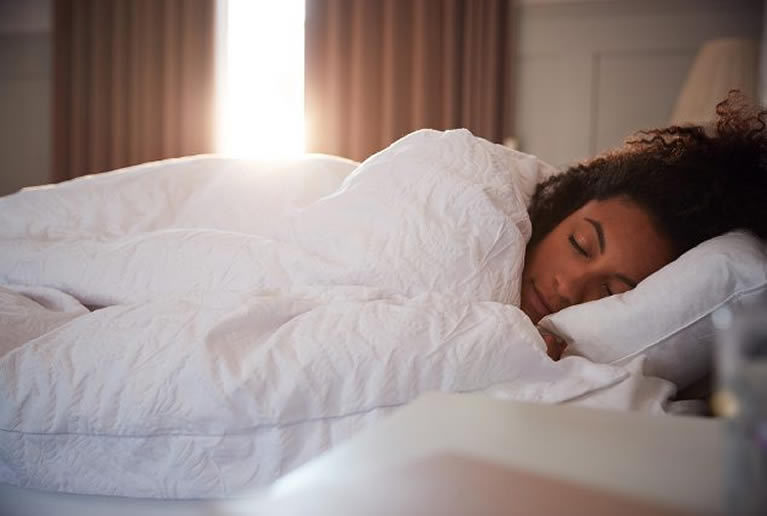
Lucid dreams are usually associated with long periods of sleep at night when we tend to slumber for many hours while the night moves towards day. But are lucid dreams only restricted to the wee small hours or can you lucid dream during the day?
You can lucid dream during the day just as easily as you can lucid dream at night. Lucid dreaming occurs during REM sleep. If you work a graveyard shift and sleep during the day then you have just as many opportunities to become lucid as someone who sleeps at night. If you nap during the day you can also experience a lucid dream but it requires a different approach.
Contents
How do you experience dreams?
Before I venture into day time lucid dreaming territory I need to first cover how we experience dreams.
Understanding the mechanics of dreaming will go a long way to helping you understand how to lucid dream during the day. So, how do we experience dreams?
As we slumber over a prolonged period we move through several sleep cycles each one of which consists of the same 3 stages of sleep: light sleep, deep sleep and REM.
We can experience dreams at any stage of sleep but we will have the most vivid dreams during REM sleep.
It is during REM that we can also experience lifelike lucid dreams.
As I have pointed out on this website many times, although it is not recommended it is possible to have multiple lucid dreams in the same sleep period due to the way the mind and body moves through a sequence of stages during multiple sleep cycles each night.
During the night, when most people sleep for several hours uninterrupted, they will move through several similar sleep cycles.
Each sleep cycle consists of three different stages.
The 3 stages of a sleep cycle:
- Light sleep. That hazy state when you are drifting off to sleep and are only vaguely aware of things around you. You can be easily woken.
- Deep sleep. This is restorative sleep where the brain is washed clean of toxins with cerebrospinal fluid and the physical body is repaired.
- REM sleep. Though you can dream at any time while asleep, this is the state where vivid dreams happen. And, this is the only stage of sleep in which lucid dreams can occur.
During the night a person will move through several sleep cycles completing the 3 stages with each cycle.
Ok, so now that we know how we experience dreams and what happens when we sleep at night, it’s time to look at the possibility of lucid dreaming during the day.
Can you lucid dream in the day?
In order to answer the question posed in this section’s subtitle I need to first identify the type of person who is asking the question.
There will be two types of people asking the question “can you lucid dream in the day”.
The first type will be someone who works a graveyard shift, or for some other reason is awake during the night hours and sleeps during the day.
If you are such a person then you will want to know if lucid dreaming is possible for you.
The second type of person who wants to know if they can lucid dream during the day will be someone who enjoys the occasional, or regular, daytime nap.
I will address the first type of person in this section and addresses the second type in the next section.
So, if you don’t sleep at night or get most of your sleep in daylight, can you lucid dream in the day?
You can just as easily lucid dream in the day as you can in the night. The same rules apply to lucid dreaming whether it is daytime or nighttime.
If you usually get your normal sleep during the day you can follow the same processes for lucid dreaming as someone who sleeps at night.
If you nap in the day you actually have a better chance of lucid dreaming but must follow a different process.
Is it normal to dream during a short nap?
In order to see if you can lucid dream during a nap we should look at whether it is normal to dream during a short nap or not.
It is completely normal to dream during a short nap.
We usually require a nap because we experienced insufficient sleep. Insufficient sleep leads to REM Deprivation.
When we nap we experience the REM Rebound effect where the brain skips the preliminary sleep stages and goes directly into REM sleep to make up for what we lost.
We always dream in REM sleep so we experience dreams when we nap.
Is it normal to lucid dream during a short nap?
For exactly the same reasons I gave above for the normality of dreaming while you nap it is just as normal to lucid dream when you nap.
In fact, it is much easier to induce a lucid dream during your nap time than it is when you go to sleep for longer periods.
As we enter REM once we fall asleep during a nap, due to the REM Rebound effect, we have a great opportunity to experience a lucid dream.
Remember, although we can dream at any time when we are asleep, lucid dreams only ever happen in REM sleep. So, the REM rebound effect that occurs during a short nap ensures we have the opportunity to experience a lucid dream.
There is a very specific technique that is used to induce a lucid dream during nap times that is extremely effective.
I cover this very topic in the article can you lucid dream during a nap and if you want to experience lucid dreams during short, or long, naps then I urge you to read that article.
Can you lucid dream while awake?
If you think that you can lucid dream while you are awake then you simply have a misunderstanding of what lucid dreaming is and what it is like. Let me clarify this.
You cannot lucid dream while you are awake. Lucid dreaming is consciously-aware dreaming.
You are awake consciously and dreaming but your physical body is asleep. In a lucid dream everything feels real and you experience it in the same way you experience reality.
It feels like you are really there but you are still in a dream. Therefore you need to be asleep to lucid dream.
Lucid dreaming can only happen, as the phrase suggests, while you are dreaming.
It is simply not possible to lucid dream while you are awake.
When you “dream” while you are awake you are experiencing a daydream.
This is an imagery string of thoughts that distract the thinker from reality. They are usually hazy and somewhat whimsical in nature.
A daydream can be controlled or just a free-flowing sequence of thoughts and images.
A sleeping dream is an experiential event in which you are totally immersed. In most dreams you feel as though you’re actually there and experiencing everything that is happening.
Dreams are usually hazy and unstructured though it is possible to have very vivid dreams that follow a logical narrative.
The only similarity between a daydream and a sleeping dream is the name.
They are created by completely different levels of consciousness and have very different brain activity associated with them.
What about a lucid dream?
A lucid dream is no different in structure and origin from a normal regular dream.
The main difference between a lucid dream and a regular dream is that you are consciously awake and aware in a lucid dream. This conscious awareness makes the dream feel real.
As you experience the dream in first person it feels like you are really in the dream experiencing everything as though it were really happening.
So, a lucid dream is just as different from a daydream as a regular dream is.
In a daydream you need to be awake.
In a regular dream and a lucid dream you need to be asleep.
Therefore you cannot possibly lucid dream while you are awake.
Obviously you could not have lucid dreaming experience if you were awake because:
- You would not be dreaming.
- You would be consciously aware of your physical body and physical surroundings and therefore not totally immersed in the dreamworld.
- You would only be daydreaming or imagining.
You therefore need to be physically asleep in order to lucid dream. This is a good thing.
If you could lucid dream while you were awake then you would just be daydreaming or visualizing and it would take all the fun and the benefits out of lucid dreaming.
For example, are you aware that lucid dreams feel so real that you can use them to improve real-world skills by practicing them in your lucid dreams.
Because practicing in a lucid dream looks and feels exactly the same as practicing in real life you can teach your brain and body how to perform skills better by performing them better in a lucid dream.
Likewise, you can also use lucid dreams to help you study, to make you smarter and even to help you achieve your goals – all because they feel just as real as the real world.
The exact opposite of an awake daydream.
If you are interested in learning how to experience lucid dreams so you can live out your fantasies in a vivid and clear lifelike world (over which you have complete and total control) then why not make the small investment required to learn this life-changing skill?
Everyone can do it and that means you too!
So, be sure to check out this amazingly good lucid dreaming course that will teach you how to induce lucid dreams and how to control every aspect of them so you can do anything you want with whomever you want to do it while simultaneously connecting you with other experienced lucid dreamers!
It is worth the effort and the small investment required.
